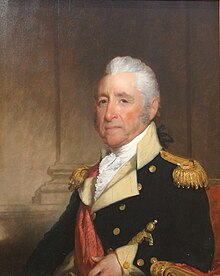John Brooks | |
|---|---|
 Portrait c. 1820 | |
| 11th Governor of Massachusetts | |
| In office May 30, 1816 – May 31, 1823 | |
| Lieutenant | William Phillips, Jr. |
| Preceded by | Caleb Strong |
| Succeeded by | William Eustis |
| Personal details | |
| Born | baptized May 4, 1752 Medford, Province of Massachusetts Bay, British America |
| Died | March 1, 1825 (aged 72) Medford, Massachusetts, U.S. |
| Political party | Federalist |
| Spouse | Lucy Smith |
| Signature | |
| Military service | |
| Branch/service | Continental Army Massachusetts militia |
| Battles/wars | American Revolutionary War
|
John Brooks (baptized May 4, 1752 – March 1, 1825) was an American doctor, military officer, and politician from Massachusetts. He served as the 11th Governor of Massachusetts from 1816 to 1823, and was one of the last Federalist officials elected in the United States.[1]
Trained as a doctor, Brooks was an officer of the Reading, Massachusetts militia when the American Revolutionary War broke out, and led his troops in the Battles of Lexington and Concord. He served under George Washington in the New York and New Jersey campaign of 1776, although he missed the Battle of Trenton due to illness. In 1777 he was part of the relief force for the Siege of Fort Stanwix, and led a successful assault against British positions in the key Second Battle of Saratoga. He played a significant role in the 1783 Newburgh Conspiracy, in which he helped quash ideas of mutiny in the Continental Army.
After the war he returned to medical practice, but continued to be active in the state militia, helping to put down Shays' Rebellion in 1787. He served in the militia during the War of 1812, after which he was elected governor. Brooks was popular and politically moderate, and came to personify the "Era of Good Feelings" that followed the war. He retired in 1823, and died two years later.
- ^ Kelly, Howard A.; Burrage, Walter L. (eds.). . . Baltimore: The Norman, Remington Company.